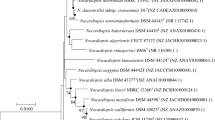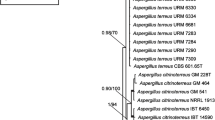Abstract
A new Eupenicillium species, E. saturniforme was isolated from soil in Jilin Province, northeast China. Morphologically, it resembled E. shearii and E. tropicum, but is distinguished from them by slowly maturing cleistothecia, lenticular ascospores with nearly smooth-walled convex surfaces, strictly velutinous colony texture with abundant conidiogenesis, robust biverticillate penicilli, apically vesiculate metulae and rough-walled stipes and conidia. The partial β-tubulin gene sequence of the new species (EU644080) showed relationship with Penicillium glabrum in the BLAST search in GenBank. Further analyses of partial calmodulin and ribosomal DNA internally transcribed spacer 1-5.8S-internally transcribed spacer 2 (rDNA ITS1-5.8S-ITS2) sequence data confirmed that E. saturniforme fell in the clade with P. glabrum, P. lividum, P. purpurascens, P. spinulosum and P. thomii of Subgenus Aspergilloides. However, E. saturniforme is a distinctive species lacking close relatives among described species of penicillia.





Similar content being viewed by others
References
Calvo AM, Wilson RA, Bok JW, Keller NP. Relationship between secondary metabolism and fungal development. Microbiol Mol Biol Rev. 2002;66:447–59. doi:10.1128/MMBR.66.3.447-459.2002.
Han D-M, Chae K-S, Han K-H. Sexual development in Aspergillus nidulans. In: Goldman GH, Osmani SA, editors. The aspergilli genomics, medical aspects, biotechnology, and research methods. Boca Raton: CRC Press; 2008. p. 279–99.
Stolk AC, Samson RA. The ascomycete genus Eupenicillium and related Penicillium anamorphs. Stud Mycol. 1983;23:1–149.
Scott DeB. The genus Eupenicillium Ludwig. Res Rep Coun Scient Ind Res Pretoria. 1968;272:1–150.
Wen DC. The chorography of Dunhua. Beijing: Xinhua Press; 1991 (in Chinese).
Pitt JI, Samson RA, Frisvad JC. List of accepted species and their synonyms in the family Trichocomaceae. In: Samson RA, Pitt JI, editors. Integration of modern taxonomic methods for Penicillium and Aspergillus classification. Amsterdam: Harwood Academic Publishers; 2000. p. 9–49.
Ueda S. A new species of Eupenicillium from marine sediment. Mycoscience. 1995;36:451–4. doi:10.1007/BF02268631.
Tuthill DE, Frisvad JC. Eupenicillium bovifimosum, a new species from dry cow manure in Wyoming. Mycologia. 2002;94:240–6. doi:10.2307/3761800.
Tuthill DE, Frisvad JC. A new species from tropical soils, Eupenicillium tropicum. Mycol Prog. 2004;3:13–8. doi:10.1007/s11557-006-0071-2.
Pitt JI. The genus Penicillium and its teleomorphic states Eupenicillium and Talaromyces. London: Academic Press; 1980 [“1979”].
Malloch D. Moulds their isolation, cultivation and identification. Toronto: University of Toronto Press; 1981.
Peterson SW. Phylogenetic analysis of Penicillium species based on ITS and lsu-rDNA nucleotide sequences. In: Samson RA, Pitt JI, editors. Integration of modern taxonomic methods for Penicillium and Aspergillus classification. Amsterdam: Harwood Academic Publishers; 2000. p. 163–78.
Frisvad JC, Samson RA. Polyphasic taxonomy of Penicillium subgenus Penicillium. A guide to identification of food and air-borne terverticillate penicillia and their mycotoxins. Stud Mycol. 2004;49:1–173. doi:10.1016/S0922-5382(04)80002-3.
Raper KB, Thom C. A Manual of the Penicillia. Baltimore, MD: Williams and Wilkins Co; 1949.
Ridgway R. Color standards and color nomenclature. Washington, DC: The Author; 1912.
Scott J, Malloch D, Wong B, Sawa T, Straus N. DNA heteroduplex fingerprinting in Penicillium. In: Samson RA, Pitt JI, editors. Integration of modern taxonomic methods for Penicillium and Aspergillus classification. Amsterdam: Harwood Academic Publishers; 2000. p. 225–36.
Glass NL, Donaldson GC. Development of primer sets designed for use with the PCR to amplify conserved genes from filamentous Ascomycetes. Appl Environ Microbiol. 1995;61:1323–30.
White TJ, Bruns T, Lee S, Taylor J. Amplification and direct sequencing of fungal ribosomal RNA genes for phylogenetics. In: Innis MA, Gelfand DH, Sninsky JJ, White TJ, editors. PCR Protocols: a guide to methods and applications. San Diego, CA: Academic Press; 1990. p. 315–22.
Wang L, Zhuang W-Y. Designing primer sets for amplification of partial calmodulin genes from penicillia. Mycosystema. 2004;23:466–73.
Wang L, Zhuang W-Y. Phylogenetic analyses of penicillia based on partial calmodulin gene sequences. Biosystems. 2007;88:113–26. doi:10.1016/j.biosystems.2006.04.008.
Hall TA. BioEdit: a user-friendly biological sequence alignment editor and analysis program for Windows 95/98/NT. Nucl Acids Symp Ser. 1999;41:95–8.
Thompson JD, Gibbson TJ, Plewniak F, Jeanmougin F, Higgins DG. The CLUSTAL-X windows interface: flexible strategies for multiple sequence alignment aided by quality analysis tools. Nucl Acids Res. 1997;25:4876–82. doi:10.1093/nar/25.24.4876.
Malloch D. The Trichocomaceae: relationships with other ascomycetes. In: Samson RA, Pitt JI, editors. Advances in Penicillium and Aspergillus systematics. New York: Plenum Press; 1985. p. 365–82.
Berbee ML, Yoshimura A, Sugiyama J, Taylor JW. Is Penicillium monophyletic? An evaluation of phylogeny in the family Trichocomaceae from 18S, 5.8S and ITS ribosomal DNA sequence data. Mycologia. 1995;87:210–22. doi:10.2307/3760907.
Swofford DL. PAUP*: Phylogenetic analysis using parsimony (*and other methods), version 4. Sunderland, MA: Sinauer Associates; 2001.
Acknowledgements
We thank Jian-Yun Zhuang for reviewing the Latin diagnosis. This study was supported by National Natural Science Foundation of China through Grant nos. 30500002 to L.W. and 30499340 and W-Y.Z., respectively, and the Knowledge Innovation Program of Chinese Academy of Sciences under Grant no. KSCX2-YW-Z-043 to L.W.
Author information
Authors and Affiliations
Corresponding author
Electronic supplementary material
Below is the link to the electronic supplementary material.
Supplementary Fig. 1
The NJ tree inferred from the rDNA ITS1-5.8S-ITS2 sequence data set. The bootstrap percentages over 50% derived from 1000 replicates were indicated at the nodes (DOC 86 kb)
Supplementary Fig. 2
One of four equally parsimonious trees generated by a heuristic search of the partial sequences of calmodulin gene data set using PAUP 4.0b8a in random sequence addition order. (Tree Length = 2033, CI = 0.4058, HI = 0.5942, RI = 0.7499, RC = 0.3043). The bootstrap percentages over 50% derived from 1000 replicates were indicated at the nodes (DOC 95 kb)
Supplementary Fig. 3
One of 943 equally parsimonious trees generated by a heuristic search of the rDNA ITS1-5.8S-ITS2 sequence data set using PAUP 4.0b8a in random sequence addition order. (Tree Length = 579, CI = 0.5043, HI = 0.4957, RI = 0.7023, RC = 0.3542). The bootstrap percentages over 50% derived from 1000 replicates were indicated at the nodes (DOC 86 kb)
Supplementary Data set 1
The 715-character alignment of partial calmodulin gene sequences (PDF 99 kb)
Supplementary Data set 2
The 592-character alignment of rDNA ITS1-5.8S-ITS2 sequences (PDF 87 kb)
Rights and permissions
About this article
Cite this article
Wang, L., Zhuang, WY. Eupenicillium saturniforme, a New Species Discovered from Northeast China. Mycopathologia 167, 297–305 (2009). https://doi.org/10.1007/s11046-008-9179-z
Received:
Accepted:
Published:
Issue Date:
DOI: https://doi.org/10.1007/s11046-008-9179-z




